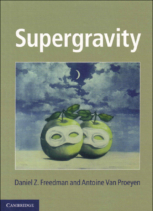By Daniel Z Freedman and Antoine Van Proeyen
Cambridge University Press
Hardback: £45
E-book: $64

Since the work of Emmy Noether nearly a century ago, the idea of symmetry has played an increasingly important role in physics, resulting in spectacular successes such as Yang-Mills gauge theory along the way. Albert Einstein, in particular, realized that symmetry could be a foundational principle; his understanding that the space–time dependent (“local”) symmetry of general co-ordinate invariance could be used to build general relativity had an enormous impact on the development of 20th-century physics.
The current zenith of the local symmetry principle is the theory of supergravity, which combines general relativity with the spin-intermingling theory of supersymmetry to construct the richest and deepest symmetry-based theory yet discovered. Supergravity also lies at the foundation of string theory – a theory whose own symmetry principle has not yet been uncovered – and so is one of the central ideas of modern high-energy theoretical physics.
Unfortunately, since its invention in the 1970s, supergravity has been an infamously difficult subject to learn. Now, two of the inventors and masters of supergravity – Dan Freedman and Antoine Van Proeyen – have produced a superb, pedagogical textbook that covers the classical theory in considerable depth.
The book is notably self-contained, with substantial and readable introductory material on the ideas and techniques that combine to make up supergravity, such as global supersymmetry, gauge theory, the mathematics of spinors and general relativity. There are many well chosen problems for the student along the way, together with compact discussions of complex geometry. After the backbone of the book on N=1 and N=2 supergravities, there is an excellent and especially clear chapter on the anti-deSitter supergravity/conformal field theory correspondence as an application.
Naturally, any finite book has to cut short some deserving topics. I hope that any second edition has an expanded discussion on superspace to complement the current, clear treatment based on the component multiplet calculus, as well as a greater discussion on supergravity and supersymmetry in the quantum regime.
Overall, this is a masterful introduction to supergravity for students and researchers alike, which I strongly recommend.





